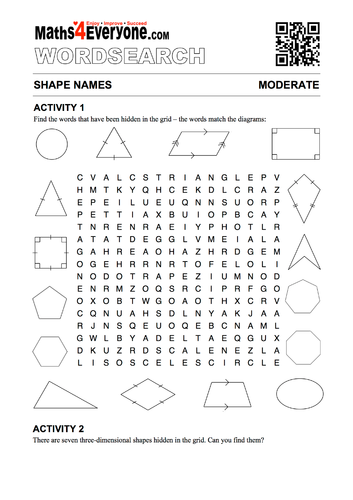




This is more than just finding words on a grid. The words are not given, they have to get them from the diagrams. There is a moderate and a 'difficult' version so the activity is accessible to all and there are many opportunities for extension. The PowerPoint reveals the solutions one word at a time so you can stop and discuss each shape as you go. Try it and you will see what I mean☺.
This has been used with classes from Year 6 to Year 11 and they have loved it and had many useful discussions.
The activity could be given as a homework as well as used in the classroom. With older students, when I go through the answers I use it as an opportunity to revise the properties of the shapes as well.
---
You can give students as much help as you like, but if you leave them to it…
Because the diagrams have been drawn for the students, there is the opportunity to talk about the use of little squares to indicate right-angles, the use of little lines to indicate equal length sides and the use of arrows to indicate parallel lines.
Three additional 2D shapes are hidden in the grid (these are nonagon, decagon and icosagon).
The 3D shapes that are hidden are cone, cube, cuboid, cylinder, pyramid, sphere & tetrahedron.
The solutions to the moderate version are contained within the pdf; the PowerPoint contains the solutions to the ‘difficult’ version.
---
If you like this activity then look through the other resources that I have uploaded by clicking -->https://tes.com/Morse's-Resources.
At the moment, I am uploading about 10 new resources each week, if you want to be kept up-to-date, then click-->HERE and then follow me.
This has been used with classes from Year 6 to Year 11 and they have loved it and had many useful discussions.
The activity could be given as a homework as well as used in the classroom. With older students, when I go through the answers I use it as an opportunity to revise the properties of the shapes as well.
---
You can give students as much help as you like, but if you leave them to it…
- they have to think about the names of the shapes;
- they have to think about the spelling of the names;
- they have to look for names that are not represented by the diagrams.
Because the diagrams have been drawn for the students, there is the opportunity to talk about the use of little squares to indicate right-angles, the use of little lines to indicate equal length sides and the use of arrows to indicate parallel lines.
Three additional 2D shapes are hidden in the grid (these are nonagon, decagon and icosagon).
The 3D shapes that are hidden are cone, cube, cuboid, cylinder, pyramid, sphere & tetrahedron.
The solutions to the moderate version are contained within the pdf; the PowerPoint contains the solutions to the ‘difficult’ version.
---
If you like this activity then look through the other resources that I have uploaded by clicking -->https://tes.com/Morse's-Resources.
At the moment, I am uploading about 10 new resources each week, if you want to be kept up-to-date, then click-->HERE and then follow me.
Something went wrong, please try again later.
Very good. Thanks for sharing.
Love this, such a great resource!
Good resource. Learners enjoyed it
Thank you! Made my life so easy and it’s adaptable too!
Another amazing resource, thanks so much!
Report this resourceto let us know if it violates our terms and conditions.
Our customer service team will review your report and will be in touch.
£0.00